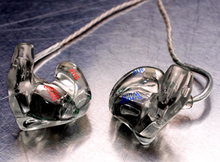

In-ear monitors, or simply IEMs or in-ears, are devices used by musicians, audio engineers and audiophiles to listen to music or to hear a personal mix of vocals and stage instrumentation for live performance or recording studio mixing. They are also used by television presenters to receive vocal instructions, information and breaking news announcements from a producer that only the presenter hears. They are often custom-fitted to an individual's ears to provide comfort and a high level of noise reduction from ambient surroundings. Their origins as a tool in live music performance can be traced back to the mid-1980s.[1]
A stage monitor system is any system that provides a mix of audio sources to a performer on stage. Traditionally, loudspeakers were placed on the stage directed toward the performers. These loudspeakers can have disadvantages. First, floor wedges greatly increase the onstage volume, in some cases to levels which could potentially damage hearing. Second, while floor wedges can be placed in front of a particular singer, guitarist, bassist, or drummer, the other musicians can often hear the other musicians' wedge mixes. In a sophisticated monitoring system, every band member can have their own monitor mix, which is their particular preference of vocals or instruments.
Since performers wear an IEM in each ear, they can also hear a stereo mix if a particular monitor system allows it. This can allow the additional definition of the audio by panning different elements (vocals, drums, etc.) to each ear. More recent advances allow the user to adjust the amount of ambient noise filtered by the IEM.
One additional consideration for mixing IEMs is that while eliminating floor wedges can improve the overall clarity of the mix for the performers and decrease the overall volume onstage, one important piece that is often lost is crowd noise and crowd comments, such as the audience calling for an encore. It is not uncommon for a microphone to be placed near each side of the stage, facing the audience, to provide a method to capture some of the crowd noise and audience comments back into the performers' IEM mixes. Larger live shows can have several microphones for this purpose spread across the front of the stage, which can also be sent to a multitrack recording device used in an outside broadcast production truck, or other destinations.[citation needed]
- ^ Ward, Phil (Oct 24, 2016). "Genius!2: Chrys Lindop and IEM (in ear monitoring) #6". Archived from the original on 2019-01-28. Retrieved 2019-01-27.